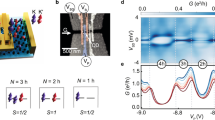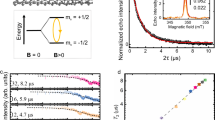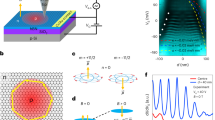Abstract
Electrons in atoms possess both spin and orbital degrees of freedom. In non-relativistic quantum mechanics, these are independent, resulting in large degeneracies in atomic spectra. However, relativistic effects couple the spin and orbital motion, leading to the well-known fine structure in their spectra. The electronic states in defect-free carbon nanotubes are widely believed to be four-fold degenerate1,2,3,4,5,6,7,8,9,10, owing to independent spin and orbital symmetries, and also to possess electron–hole symmetry11. Here we report measurements demonstrating that in clean nanotubes the spin and orbital motion of electrons are coupled, thereby breaking all of these symmetries. This spin–orbit coupling is directly observed as a splitting of the four-fold degeneracy of a single electron in ultra-clean quantum dots. The coupling favours parallel alignment of the orbital and spin magnetic moments for electrons and antiparallel alignment for holes. Our measurements are consistent with recent theories12,13 that predict the existence of spin–orbit coupling in curved graphene and describe it as a spin-dependent topological phase in nanotubes. Our findings have important implications for spin-based applications in carbon-based systems, entailing new design principles for the realization of quantum bits (qubits) in nanotubes and providing a mechanism for all-electrical control of spins14 in nanotubes.
This is a preview of subscription content, access via your institution
Access options
Subscribe to this journal
Receive 51 print issues and online access
$199.00 per year
only $3.90 per issue
Buy this article
- Purchase on Springer Link
- Instant access to full article PDF
Prices may be subject to local taxes which are calculated during checkout




Similar content being viewed by others
References
Kane, C. L. & Mele, E. J. Size, shape, and low energy electronic structure of carbon nanotubes. Phys. Rev. Lett. 78, 1932–1935 (1997)
Cobden, D. H. & Nygard, J. Shell filling in closed single-wall carbon nanotube quantum dots. Phys. Rev. Lett. 89, 046803 (2002)
Liang, W. J., Bockrath, M. & Park, H. Shell filling and exchange coupling in metallic single-walled carbon nanotubes. Phys. Rev. Lett. 88, 126801 (2002)
Jarillo-Herrero, P. et al. Electronic transport spectroscopy of carbon nanotubes in a magnetic field. Phys. Rev. Lett. 94, 156802 (2005)
Jarillo-Herrero, P. et al. Orbital Kondo effect in carbon nanotubes. Nature 434, 484–488 (2005)
Moriyama, S. et al. Four-electron shell structures and an interacting two-electron system in carbon-nanotube quantum dots. Phys. Rev. Lett. 94, 186806 (2005)
Sapmaz, S. et al. Electronic excitation spectrum of metallic carbon nanotubes. Phys. Rev. B 71, 153402 (2005)
Cao, J., Wang, Q. & Dai, H. Electron transport in very clean, as-grown suspended carbon nanotubes. Nature Mater. 4, 745–749 (2005)
Makarovski, A., An, L., Liu, J. & Finkelstein, G. Persistent orbital degeneracy in carbon nanotubes. Phys. Rev. B 74, 155431 (2006)
Makarovski, A., Zhukov, A., Liu, J. & Finkelstein, G. SU(2) and SU(4) Kondo effects in carbon nanotube quantum dots. Phys. Rev. B 75, 241407 (2007)
Jarillo-Herrero, P. et al. Electron–hole symmetry in a semiconducting carbon nanotube quantum dot. Nature 429, 389–392 (2004)
Ando, T. Spin–orbit interaction in carbon nanotubes. J. Phys. Soc. Jpn. 69, 1757–1763 (2000)
Huertas-Hernando, D., Guinea, F. & Brataas, A. Spin–orbit coupling in curved graphene, fullerenes, nanotubes, and nanotube caps. Phys. Rev. B 74, 155426 (2006)
Nowack, K. C., Koppens, F. H. L., Nazarov, V. & Vandersypen, L. M. K. Coherent control of a single electron spin with electric fields. Science 318, 1430–1433 (2007)
Loss, D. & DiVincenzo, D. P. Quantum computation with quantum dots. Phys. Rev. A. 57, 120–126 (1998)
Elzerman, J. M. et al. Single-shot read-out of an individual electron spin in a quantum dot. Nature 430, 431–435 (2004)
Petta, J. R. et al. Coherent manipulation of coupled electron spins in semiconductor quantum dots. Science 309, 2180–2184 (2005)
Bulaev, D. V., Trauzettel, B. & Loss, D. Spin–orbit interaction and anomalous spin relaxation in carbon nanotube quantum dots. Preprint at 〈http://arXiv.org/abs/0712.3767〉 (2007)
Trauzettel, B., Bulaev, D. V., Loss, D. & Burkard, G. Spin qubits in graphene quantum dots. Nature Phys. 3, 192–196 (2007)
Awschalom, D. D. & Flatte, M. E. Challenges for semiconductor spintronics. Nature Phys. 3, 153–159 (2007)
Sahoo, S. et al. Electric field control of spin transport. Nature Phys. 1, 99–102 (2005)
Tombros, N., van der Molen, S. J. & van Wees, B. J. Separating spin and charge transport in single-wall carbon nanotubes. Phys. Rev. B 73, 233403 (2006)
Tombros, N. et al. Electronic spin transport and spin precession in single graphene layers at room temperature. Nature 448, 571–574 (2007)
Minot, E. D., Yaish, Y., Sazonova, V. & McEuen, P. L. Determination of electron orbital magnetic moments in carbon nanotubes. Nature 428, 536–539 (2004)
Cobden, D. H. et al. Spin splitting and even–odd effects in carbon nanotubes. Phys. Rev. Lett. 81, 681–684 (1998)
Oreg, Y., Byczuk, K. & Halperin, B. I. Spin configurations of a carbon nanotube in a nonuniform external potential. Phys. Rev. Lett. 85, 365–368 (2000)
Ralchenko et al. Atomic Spectra Database Version 3.1.3 (National Institute of Standards and Technology, Gaithersburg, Maryland) 〈http://physics.nist.gov/asd3〉 (accessed, 14 November 2007)
Acknowledgements
We thank E. Altman, Y. Gefen, C. L. Henley, Y. Meir, E. Mueller, Y. Oreg, E. I. Rashba, A. Stern and B. Trauzettel for discussions. This work was supported by the NSF through the Center for Nanoscale systems, and by the MARCO Focused Research Center on Materials, Structures and Devices. Samples were fabricated at the Cornell node of the National Nanofabrication Users Network, funded by NSF.
Author Contributions F.K. and S.I. fabricated the devices and performed the experiments. F.K., S.I., D.C.R. and P.L.M. analysed the data and co-wrote the paper. All authors discussed the results and commented on the manuscript.
Author information
Authors and Affiliations
Corresponding author
Supplementary information
Supplementary Information
The file contains Supplementary Discussion and Supplementary Figures S1-S2 with Legends. This document discusses how the one-electron and one-hole quantum dots are identified, and how the few-electron addition spectra are affected by higher longitudinal modes. Two Figures further compare quantum dots localized over different gate electrodes and schematically contrast the effects of spin-orbit coupling and KK’ scattering. (PDF 299 kb)
Rights and permissions
About this article
Cite this article
Kuemmeth, F., Ilani, S., Ralph, D. et al. Coupling of spin and orbital motion of electrons in carbon nanotubes. Nature 452, 448–452 (2008). https://doi.org/10.1038/nature06822
Received:
Accepted:
Issue Date:
DOI: https://doi.org/10.1038/nature06822
This article is cited by
-
Spin-valley coupling in single-electron bilayer graphene quantum dots
Nature Communications (2021)
-
Kondo effect and spin–orbit coupling in graphene quantum dots
Nature Communications (2021)
-
Atomic-like charge qubit in a carbon nanotube enabling electric and magnetic field nano-sensing
Nature Communications (2020)
-
Chirality effects on an electron transport in single-walled carbon nanotube
Scientific Reports (2020)
-
Electrical control of spins and giant g-factors in ring-like coupled quantum dots
Nature Communications (2019)
Comments
By submitting a comment you agree to abide by our Terms and Community Guidelines. If you find something abusive or that does not comply with our terms or guidelines please flag it as inappropriate.



